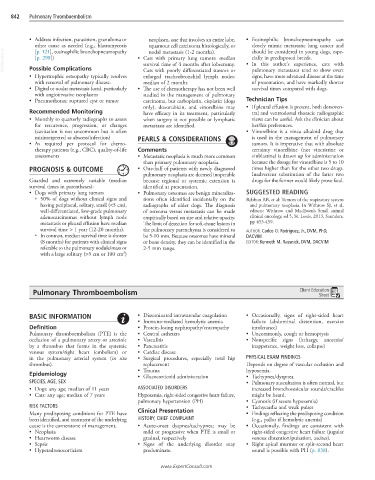Page 1677 - Cote clinical veterinary advisor dogs and cats 4th
P. 1677
842 Pulmonary Thromboembolism
• Address infection, parasitism, granuloma or neoplasm, one that involves an entire lobe, • Eosinophilic bronchopneumopathy can
other cause as needed (e.g., blastomycosis squamous cell carcinoma histologically, or closely mimic metastatic lung cancer and
VetBooks.ir Possible Complications • Cats with primary lung tumors: median • In this author’s experience, cats with
[p. 121], eosinophilic bronchopneumopathy
should be considered in young dogs, espe-
nodal metastasis (1-2 months).
cially in predisposed breeds.
[p. 298])
survival time of 4 months after lobectomy.
enlarged tracheobronchial lymph nodes:
signs, have more advanced disease at the time
• Hypertrophic osteopathy typically resolves Cats with poorly differentiated tumors or pulmonary metastases tend to show overt
with removal of pulmonary disease. median of 2 months of presentation, and have markedly shorter
• Digital or ocular metastasis (cats), particularly • The use of chemotherapy has not been well survival times compared with dogs.
with angioinvasive neoplasms studied in the management of pulmonary
• Pneumothorax: ruptured cyst or tumor carcinoma, but carboplatin, cisplatin (dogs Technician Tips
only), doxorubicin, and vinorelbine may • If pleural effusion is present, both dorsoven-
Recommended Monitoring have efficacy in its treatment, particularly tral and ventrodorsal thoracic radiographic
• Monthly to quarterly radiographs to assess when surgery is not possible or lymphatic views can be useful. Ask the clinician about
for recurrence, progression, or changes metastasis are identified. her/his preferences.
(cavitation is not uncommon but is often • Vinorelbine is a vinca alkaloid drug that
misinterpreted as abscess/infection) PEARLS & CONSIDERATIONS is used in the management of pulmonary
• As required per protocol for chemo- tumors. It is imperative that with absolute
therapy patients (e.g., CBC), quality-of-life Comments certainty vinorelbine (not vincristine or
assessments • Metastatic neoplasia is much more common vinblastine) is drawn up for administration
than primary pulmonary neoplasia. because the dosage for vinorelbine is 5 to 10
PROGNOSIS & OUTCOME • One-half of patients with newly diagnosed times higher than for the other two drugs.
pulmonary neoplasia are deemed inoperable Inadvertent substitution of the latter two
Guarded and extremely variable (median because regional or systemic extension is drugs for the former would likely prove fatal.
survival times in parentheses): identified at presentation.
• Dogs with primary lung tumors • Pulmonary osteomas are benign mineraliza- SUGGESTED READING
○ 50% of dogs without clinical signs and tions often identified incidentally on the Rebhun RB, et al: Tumors of the respiratory system
having peripheral, solitary, small (<5 cm), radiographs of older dogs. The diagnosis and pulmonary neoplasia. In Withrow SJ, et al,
well-differentiated, low-grade pulmonary of osteoma versus metastasis can be made editors: Withrow and MacEwen’s Small animal
adenocarcinomas without lymph node empirically based on size and relative opacity. clinical oncology, ed 5, St. Louis, 2013, Saunders,
metastasis or pleural effusion have median The limit of detection for soft-tissue lesions in pp 453-459.
survival time > 1 year (12-20 months). the pulmonary parenchyma is considered to AUTHOR: Carlos O. Rodriguez, Jr., DVM, PhD,
○ In contrast, median survival time is shorter be 5-10 mm. Because osteomas have mineral DACVIM
(8 months) for patients with clinical signs or bone density, they can be identified in the EDITOR: Kenneth M. Rassnick, DVM, DACVIM
referable to the pulmonary nodule/mass or 2-5 mm range.
3
with a large solitary (>5 cm or 100 cm )
Pulmonary Thromboembolism Client Education
Sheet
BASIC INFORMATION • Disseminated intravascular coagulation • Occasionally, signs of right-sided heart
• Immune-mediated hemolytic anemia failure (abdominal distention, exercise
Definition • Protein-losing nephropathy/enteropathy intolerance)
Pulmonary thromboembolism (PTE) is the • Central catheters • Uncommonly, cough or hemoptysis
occlusion of a pulmonary artery or arteriole • Vasculitis • Nonspecific signs (lethargy, anorexia/
by a thrombus that forms in the systemic • Pancreatitis inappetence, weight loss, collapse)
venous system/right heart (embolism) or • Cardiac disease
in the pulmonary arterial system (in situ • Surgical procedures, especially total hip PHYSICAL EXAM FINDINGS
thrombus). replacement Depends on degree of vascular occlusion and
• Trauma hypoxemia.
Epidemiology • Glucocorticoid administration • Tachypnea/dyspnea
SPECIES, AGE, SEX • Pulmonary auscultation is often normal, but
• Dogs: any age; median of 11 years ASSOCIATED DISORDERS increased bronchovesicular sounds/crackles
• Cats: any age; median of 7 years Hypoxemia, right-sided congestive heart failure, might be heard.
pulmonary hypertension (PH) • Cyanosis (if severe hypoxemia)
RISK FACTORS • Tachycardia and weak pulses
Many predisposing conditions for PTE have Clinical Presentation • Findings reflecting the predisposing condition
been identified, and treatment of the underlying HISTORY, CHIEF COMPLAINT (e.g., pallor if hemolytic anemia)
cause is the cornerstone of management. • Acute-onset dyspnea/tachypnea; may be • Occasionally, findings are consistent with
• Neoplasia mild or progressive when PTE is small or right-sided congestive heart failure (jugular
• Heartworm disease gradual, respectively venous distention/pulsation, ascites).
• Sepsis • Signs of the underlying disorder may • Right apical murmur or split-second heart
• Hyperadrenocorticism predominate. sound is possible with PH (p. 838).
www.ExpertConsult.com

